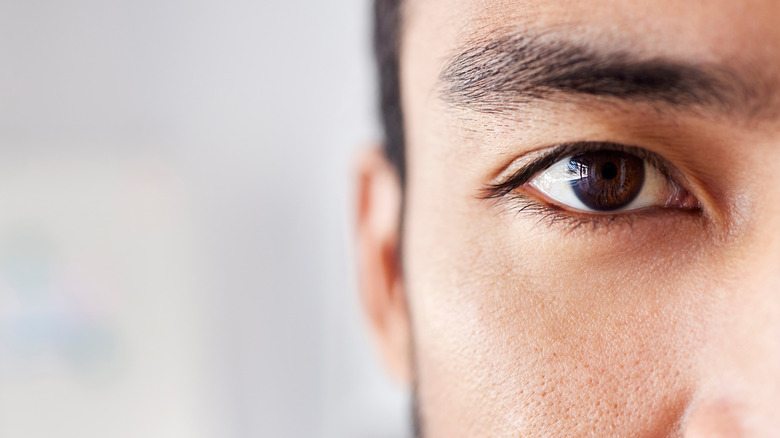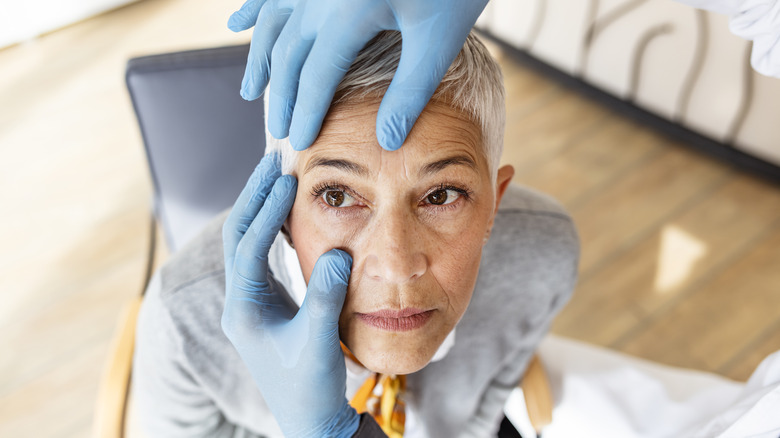People With Dark Eyes Are More Likely To Develop This Medical Condition
No matter where you look, odds are, you're likely to spot someone with dark eyes. After all, it's estimated that as many as 79% of people around the globe possess brown eyes, according to experts at Mississippi Eye Care. To get even more specific, those in Europe, West Asia, or the Americas are more likely to have light brown eyes while individuals in East Asia, Southeast Asia, and Africa tend to have dark brown eyes.
Influenced by our genetics, eye color is the result of how much melanin is contained in the frontmost layer of the eye, explained the Cleveland Clinic. The more melanin (or pigment) present, the darker our eyes will be — or more specifically, the iris. Depending on our eye color, some people may be more prone to certain health conditions. Those with light eyes, for example, tend to be more susceptible to macular degeneration while people with dark eyes may be at a higher risk for cataracts (per WebMD). If you thought cataracts were something only your grandmother could get, you may be surprised to know that a growing number of young people have been undergoing cataract surgery, too (via Linda Vision).
What are cataracts?
Once we turn 40, we start to experience aging-related changes to our vision, per the American Academy of Ophthalmology. This includes a breakdown of proteins located in the eye's lens or the part of the eye responsible for light refraction. While this lens is normally clear, those with cataracts develop a progressive cloudiness in their lenses which may cause blurring, double vision, light sensitivity, muted colors, and more. Cataracts aren't always a product of aging, however. Smoking, eye injuries, sun exposure, genetics, various health conditions, or the use of certain medications can all contribute to the development of cataracts. As it turns out, our eye color may, too.
In a 2000 study published in the American Journal of Ophthalmology titled The Blue Mountains Eye Study, researchers examined the lenses of more than 3,600 people in Australia. The findings revealed that compared to people with light iris colors, those with dark brown eyes were 1.5 times more susceptible to nuclear cataracts and 2.5 times more prone to posterior subcapsular cataracts. The Mayo Clinic explained that nuclear cataracts impact the middle of the lens while posterior subcapsular cataracts develop in the back of the lens.
What's the link between dark eyes and cataracts?
Experts at the Vision Eye Institute explain that the connection between dark iris colors and cataracts can be likened to wearing a black tee shirt on a sunny day — an example we can all certainly relate to. It doesn't take long before that black shirt becomes uncomfortably hot. This is because while white reflects light, black absorbs it. Similarly, the dark pigment of the iris is thought to take in more light and subsequently heat the lens, which results in clouding over time.
Alternatively, some experts suggest that it's not so much the color of the eye itself that increases one's risk for cataracts but more so the geographical locations of people with dark eyes. "We know there is a connection between sun exposure and cataracts, and most people with darker eyes live closer to the equator," spokesperson for the American Academy of Ophthalmology Dr. Davinder Grover told AARP.
While there may be some differing theories as to the cause of this link, what experts do agree on is that proper protection from UV rays is of the utmost importance when it comes to our vision as well as our overall health. Regardless of age, it's important to wear sunglasses that offer full UV protection while outdoors.



